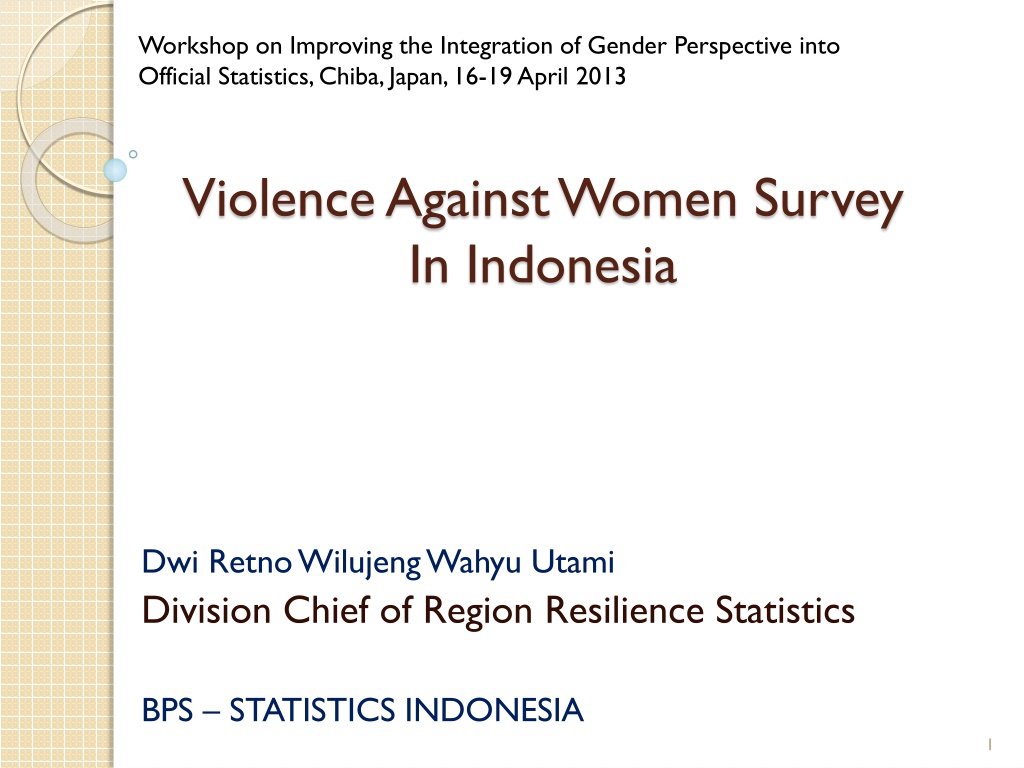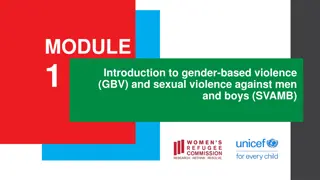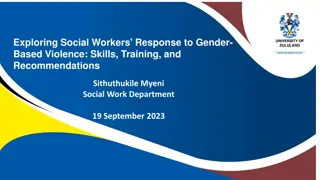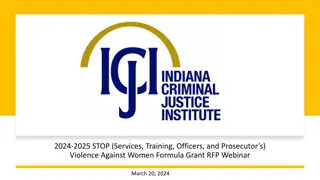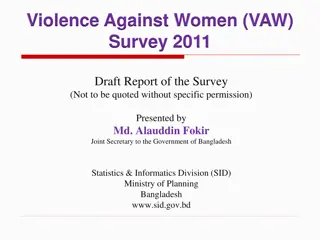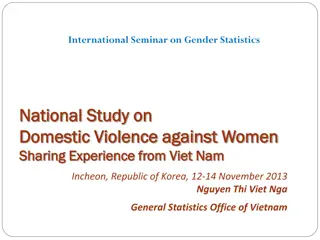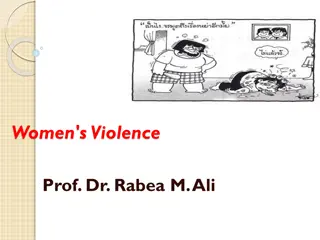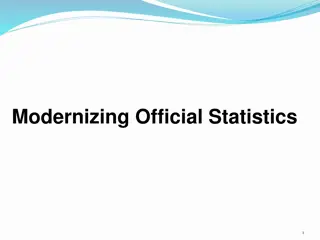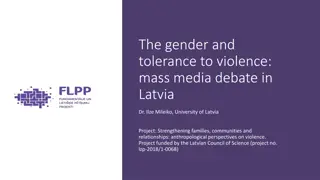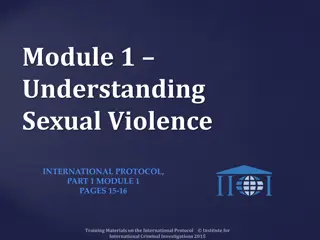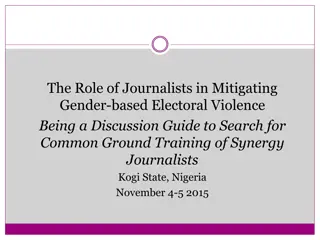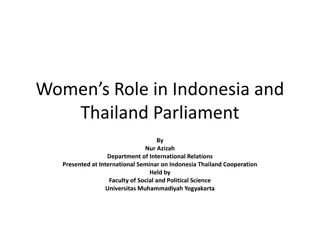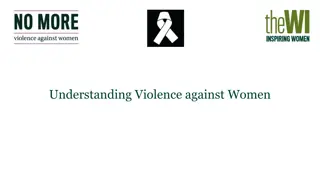Workshop on Improving Gender Integration into Official Statistics - Indonesia's Violence Against Women Survey
Explore Indonesia's efforts in combating violence against women through surveys and data collection techniques, focusing on the 2006 and 2014 surveys. Learn about the sampling design, training methods for interviewers, and the types of violence covered, including physical, psychological, and economic aspects.
Download Presentation

Please find below an Image/Link to download the presentation.
The content on the website is provided AS IS for your information and personal use only. It may not be sold, licensed, or shared on other websites without obtaining consent from the author. Download presentation by click this link. If you encounter any issues during the download, it is possible that the publisher has removed the file from their server.
E N D
Presentation Transcript
Workshop on Improving the Integration of Gender Perspective into Official Statistics, Chiba, Japan, 16-19 April 2013 Violence Against Women Survey In Indonesia Dwi RetnoWilujengWahyu Utami Division Chief of Region Resilience Statistics BPS STATISTICS INDONESIA 1
Topics The 2006 Survey of Violence against Women and Children in Indonesia The Planning of 2014 Survey of Violence against Women in Indonesia 2
The 2006 Survey of Violence against Women and Children in Indonesia 3
Data collection Type of data collection: module integrated in the 2006 National Socio Economic Survey (SUSENAS), using special questionnaire Sample: 68,800 households Estimation level: province and national Method: Interview Interviewers: Susenas interviewers Target respondent: (1)Women: All women aged 18+ or ever married women of aged less than 18 (2) Children: Aged less than 18 years old and never married. 4
Sampling Design Two Stage Double Sampling Design for both urban and rural areas First Stage, From 13.097 core cb selected 4.300 cb were then selected by linear systematic for 2006 Violence against Women and Children Survey Second Stage, 16 household were then systematically selected from the listing. From each selected hhs could be elected one or more women depending on the existing of experiencing violence 5
Training and Interviewer Provided only one day training for VAW after 3 days of SUSENAS training Aspect covered in the training were how to asking questions, type, concep and definition of violence, private place for victim Interviewer: mix men and women, but SUSENAS interviewers dominated by man 6
Types of Violence covered Physical (such as: being beaten, tortured, etc) Psychological (such as: being insulted, threatened, etc) Rape/sexual intercourse Coercive abortion Forced sex with non-partner Other sexual violence Neglected (not giving living) Forced to work Prohibition of work 10. Other economic violence 11. Trafficking of women, children and infants 1. 2. 3. 4. 5. 6. 7. 8. 9. 7
Phrasing and Sequencing of Questions Where have experienced on violence during 2006? (options: at home, outside home, at work, never) During 2006, how many times have experienced violence?(options: once, several times, almost every month, almost every weeks, almost every day) What is the most serious effect caused by the violence? (options: injuri/disability, stress/depression, recentment, material, others) 1. 2. 3. 8
Phrasing and Sequencing of Questions (cont) 4. The main reasons of violence? (options: economic difficulties, not obedient, bad behavior, jelous) 5. To whom asking for protection/first report? (options: family, police, NGO, religious/community leader, others, not reported) 6. Who was provided the last recovery (options: hospital, religious/community leader, NGO, others) 7. Who was the main perpetrators of violence (options: husband/partner, parent, child/grand child, family, neighbor, boss, co-worker, teacher, others) 9
Main Challenges in Data Collection VAW survey interviews conducted after the enumeration of SUSENAS questionnaires It is not easy to collect data on sensitive topics, such as information about violence of women who are victims, especially when the perpetrator is her husband Women and Children regard the domestic violence as private matter, not for the public domain (taboo) 10
The Results Figure 1. Woman Victim by Area (%) 3.08 3.07 3.06 Total Urban Rural Total number of woman victims in 2006 was 2.3 million or 3. 07 percent. Victims of violence against women in rural areas are higher than in urban areas (1.3 million versus 1.0 million) 11
Figure 2. Women Victims by Type of Violence (%) 65.8 65.3 64.7 Total Urban Rural 25.3 23.3 20.7 18.2 18.0 17.9 17.7 16.2 14.5 12.8 11.3 10.2 Persecution Humiliation Harassment Neglect Others Most violence type is humiliation. Nearly two out of three women victims of violence in both urban and rural areas have experienced in humiliation 12
Figure 3. Violence against Women by The Worst Consequence (%) 7.3 Others 6.5 Rural 6.9 Urban 9.9 Total Material 10.0 10.0 71.0 Resentment 67.7 69.5 7.2 Stress/Depression 11.2 9.0 4.6 Wound/disabilities 4.6 4.6 The most effect received by the victim was resentment, reaching 69.5 percent. This is in line with the highest type of violence experienced by victims is humiliation 13
Figure 4. Women Victims by Crime Scene and Area 72.1 68 64.1 Urban Rural Total 30.2 27 24.4 4.8 3.4 2.2 2.1 1.5 0.9 at home outside working place two place or more 14
Figure 5. Violence against Women by The Major Cause (%) 34.2 25.8 14 13.6 12.5 Economic Difficulties Non-compliant Bad Behavior Jealous Others About one-third cases of violence against women is caused due to economic difficulties. These factors become the main cause of most violence against women. 15
Figure 6. Violence against Women by Frequency of Occurrence (%) 50.6 31.9 7.6 7.1 2.8 Once Several Times Almost Every Month Almost Every Week Almost Everyday Half of the number cases of violence against women occur over several times. Only about one-third of the number of cases of violence, done only once. This fact indicates that two-thirds of cases of violence against women occur more than once. 16
Table 1. Violence against Women by Perpetrator (%) Subject Urban 50.6 Rural 58.8 Total 55.1 Husband Parents/Parents in law Children/Grandchildren Family Neighbor Boss Co-workers Teacher Others 3.8 2.4 4.9 17.9 3.6 4.4 0.3 12.1 5.4 1.7 5.2 21.0 1.6 1.7 0.0 4.6 4.7 2.0 5.0 19.6 2.5 2.9 0.2 8.0 Most of perpetrator of violence against women is someone close to the victim. More than half (55.1 percent) violence conduct by their husband . 17
Figure 7. Violence against Women by The Place to Ask for Protection (%) Don't Know 4.4 Not Reported 54.9 Others 4.0 Religious/Community Figures 2.5 NGO/social worker 0.2 Police 1.9 Family 32.2 18
Figure 8. Women Victim by Province Series 1 16 14 12 10 8 6 4 2 0 19
Follow Up Study In 2007, on 16 regency/municipality of 8 provinces, with the objectives are: To completed the information about the main reason of violence, Get a picture about attitudes toward violence victims that they had experienced Attempt of victim to find help Attempt of related institutions in handling the victim of violence 20
Follow Up Study (cont) In 2007, research on Evaluation of Implementation Law No. 23/2004 on Domestic Violence Elimination Conducted in 5 provinces At 6 related institutions in district/municipality: women empowerment bureau, health department, police, hospital, Social department and NGO/legal aid 21
Lesson Learned from 2006 VAW Survey VAW survey should be conducted as dedicated survey, with specific training and specific interviewer Eligible respondent not women aged 18+, but should woman aged 15-64 years and only elected one women per household Used women interviewers Taking into account the sensitivity of the issue, not elected 16 household per cencus block but reducing to 10 hhs per cencus block Should refer to safety of the respondent and ethical behavior of interviewer 22
The Planning of 2014 Survey of Violence against Women in Indonesia In 2012, developing the questionnaires and manual used for 2014 VAW survey (adopting WHO methodology) In 2013, instrumen testing in 4 regency/municipality In 2014, VAW survey that will cover 24 provinces with 9.000 samples, interview using handheld/PDA Financial Supporting by UNFPA 23
Thank You 24
